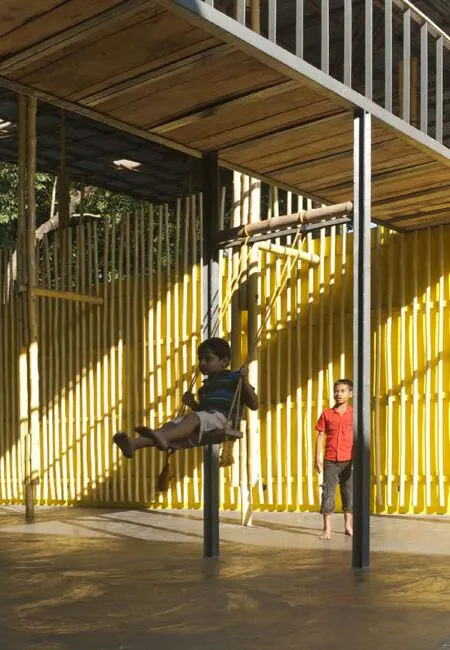帕尼社区中心,拉贾哈特,孟加拉
2016-07-19PaniCommunityCenterRajarhatBangladesh2014
Pani Community Center, Rajarhat, Bangladesh, 2014
建筑设计:施尔德·斯科尔特建筑事务所Architects: SchilderScholte architects
帕尼社区中心,拉贾哈特,孟加拉
Pani Community Center, Rajarhat, Bangladesh, 2014
建筑设计:施尔德·斯科尔特建筑事务所
Architects: SchilderScholte architects
荷兰帕尼基金会委托我们的工作室在孟加拉北部设计一座教育性建筑。作为建筑师,我们非常欢迎这种分享知识的正能量公益项目。这座只使用本地材料、工艺和技术建成的环境友好型建筑为社区带来了十分积极的影响。
“我们的目标是在这个穆斯林社区中为没有土地的贫民提供教育,并改善卫生和教育水平,降低儿童死亡率,保证经济独立,最终放大基金会资助带来的效益!”
其出发点是用场地方圆25km内的材料来整合和优化本地的技术。我们与孟加拉的承包商和木匠一起检查哪些产品是可用的。在设计过程中重点关注的是本地材料和天气情况。其中的动力在于鼓励本地人理解可持续性的原则和耐久建筑的理念。在施工中几乎实现了电能和化石能的零消耗。
我们的策略是让本地施工过程的发展和现代化不致出现工匠的技术断层。首先要学习本地施工工人所需的技能,以实现长远策划,并为人们建立信心,在实践中融入新的知识和技能。例如,我们使用了一种非本地的砖砌法,即使不是整体砖墙也能保证稳定性,这样就在保留主要优势、本地材料和工艺的情况下将成本降至最小。该项目使用的所有建筑技术都易学易用,并由承包商进行普及,而这就已经推动了本地施工的现代化。
虽然竹子在这一地区被视为低档材料,但我们还是选择用它建造整个屋顶。甚至工作室的墙面和门的部分都覆上了竹子!它也暗示着竹质自行车架也是在这里加工的。
从生物气候的角度看,建筑的朝向与热带屋顶保证了自然对流通风。此外,设计中还考虑到利用附近池塘的自然气流给教室降温。从侧面悬挂的U形屋顶提供了遮阳,既为建筑中最大的洞口挡雨,又给院内收集雨水。这里还进行了仿生试验!室内墙壁的淡蓝色调能驱赶苍蝇。教室窗户斜面上的黄色调会让特定的昆虫跑开。有了这些低技要素就几乎不再需要杀虫剂和电扇。
这个社区中心已然成为小镇的骄傲,还是人们最喜爱的自拍点。□(尚晋 译)

1
1 带池塘的西立面/West facade with pond

2

3
2 草图/Sketch
3 广场空地/Plaza view

4
4 北立面/North facade
Te Dutch Pani Foundation commissioned our ofce to design an educational building in the north of Bangladesh. We as architects embraced this pro bono assignment coming from ideological motives and knowledge sharing. By making use of local materials, craftsmanship and skills exclusively, an environmentally friendly building has been realized that contributes to the community in a significant way.
"Te goal is to train the poor and landless in this Muslim community, improve the hygiene and work on education, reduce child mortality and ensure economic independence eventually making the fnancial support of the foundation superfuous!"
Te starting point was to combine and optimize local techniques and skills with materials to be found within a 25 km radius from the site. Together with the Bengal contractors and carpenters we looked at what products were available. During the design process, attention was mainly focused on local available materials and climatic conditions. Te motivation was to encourage locals to become aware of the basic principles of sustainability and durable building concepts. In effect close to zero electricity or fossil fuels were used during construction.
This strategy was to participate in the evolution and modernization of the local construction processes without a rupture in the "know how" of the artisans. This began with learning the local construction workers necessary skills required for long-term planning and develop confidence to bring into practice new knowledge and skills. We for instance introduced a locally unknown brickwork bond that doesn't require whole-brick walls for stability, thus minimizing the costs and maintaining the main advantage,the use of local materials and craftsmanship. All the building techniques used for this project are very easy to learn and diffused by the main contractor, which has already contributed to the local construction modernization.
Although bamboo is seen as an inferior material in the region, we chose to make the whole roof construction out of it. Even the walls and French doors of the workshop are cladded with it,a reference to the bamboo bicycle frames that are made here.
From a bioclimatic point of view theorientation of the building together with the tropical roof ensures natural cross ventilation. Also the use of nearby ponds for natural draft to cool the classrooms was taken into account in the design. The U-shaped roof is suspended to the sides providing shade, protecting the biggest openings against rain and collecting rainwater into the courtyard. Some bio mimicry elements are put on the test here! The interior walls are colored in light blue, a hue that flies shun. The splay of the classroom windows are painted yellow, a hue that specifc insects dislike. Tese low tech features have proven to reduce the use of insecticides and electric fans to minimum.
Te community center has become the pride of the town and a favorite selfe spot.

5

6
5 总平面/Site plan
6 荡秋千的孩子/Child on swing

7

8
7 傍晚的南立面/South facade at evening
8 剖面图/Sections

9

10

11

12
9 教室间的连廊/Landing between classrooms
10 首层平面/Ground foor
11 二层平面/Upper foor
1-商店/Store
2-实验室/Workshop
3-储藏室/Storage
4-工作间/Workplace
5-广场/Plaza
6-庭院/Courtyard
7-教室/Classroom
8-女洗手间/Ladies lavatory
9-男洗手间/Gents lavatory
10-教室/Classroom
11-集合平台/Assembly foor
12-走廊/Footbridge
13-教室/Classroom
14-仓库+水池/Storage + Water tank
15-平台/Landing
16-仓库+水池/Storage + Water tank
17-教室/Classroom
12 屋顶/Roof

13

14
13 遮荫的空地/Roofed workfoor
14 课堂/Classroom lesson
评论
朱颖心:这是在经济不发达地区为贫民提供服务的建筑,其策略为只使用本地材料、工艺和技术,保证建造过程的低成本和低消耗,并要求使用时尽量降低能源需求。建筑地处于亚热带气候,全年湿热多雨。整个建筑都采用了向室外半敞开、通透的空间,保证了良好的自然通风,避免了日晒,为当地人群提供了适应湿热气候的热舒适环境。屋顶提供了遮阳和挡雨的功能,屋顶未及的内院部分均维持原有的透水地面,以保证雨水的收集。利用仿生技术的特定墙面颜色驱赶昆虫也是非常有独创性的!
宋晔皓:这个案例让我想起了舒马赫在《小的是美好的》一书中所提出的“中间技术”的概念,以及所奠定的适宜技术理论基础。所谓中间技术,通俗地说,就是介乎价值1000英镑的现代技术和1英镑的当地技术之间的100英镑的技术,即利用现代工艺,又结合传统,可以推广和应用。竹子在当地被视为低档材料,如果出现在以试错为主要方法的地方,不会没有客观上的原因,例如因为使用寿命不佳,或结构强度不够。如果类似上述的担心被建筑师解决,同时如建筑师所言,提供给地方一个环境友好且耐久的建筑,则竹子的应用就是一个创造性设计。
项目信息/Credits and data
设计团队/Design Team: Gerrit Schilder & Hill Scholte
结构工程师/Structural Engineer: Dick van Gemerden
承建商/Contractor: MEI
客户/Client: 帕尼基金会/Pani Foundation
建筑面积/Floor Area: 768m2
造价/Building Cost: €44,000
开工时间/Construction: 2012.11
竣工时间/Completion: 2014.10
摄影/Photos: SchilderScholte

15
15 聚集空间/Gathering place
Comments
ZHU Yingxin: It serves the poor people in economically underdeveloped areas. It adopts the strategies of using only local materials, crafts and technology, ensuring low costs and low consumption during the construction, and requiring to reduce energy demand as much as possible in usage. Te building is located in the place of sub-tropical climate, i.e. hot and rainy all year. Te whole building is a semi-open and transparent space, which ensures good natural ventilation and avoids excessive sunlight, so as to provide an environment with comfortable heat to the local people, who are adapted to hot and humid climate. Te roof functions to keep from sunlight and rain, the inner yard untouched by which maintains the original waterpermeable ground to guarantee rainwater collection. In addition, the application of bio technology to drive insects away with specifc wall colors is also ingenious!
SONG Yehao: This case reminds me the concept of intermediate technology,which paved the theoretical basis for appropriate technology that E. F. Schumacher presented in his Small is Beautiful. Te so-called intermediate technology, popularly speaking, is a choice of the 100-pound-valued technology given the range of choices between modern technologies valued at 1000 pounds and local technologies at one pound; that is, to use both modern technique and tradition technology for promotion and application. Bamboo is regarded by local people as low-grade material. If it appears in the places that take "trial and error" as the main method,there will be objective reasons, perhaps because of poor life of usage, or low structural strength. If the above concerns are resolved by the architect, and as the architect says, an environment-friendly and durable building is set up in the place,the application of bamboo is a creative design.
